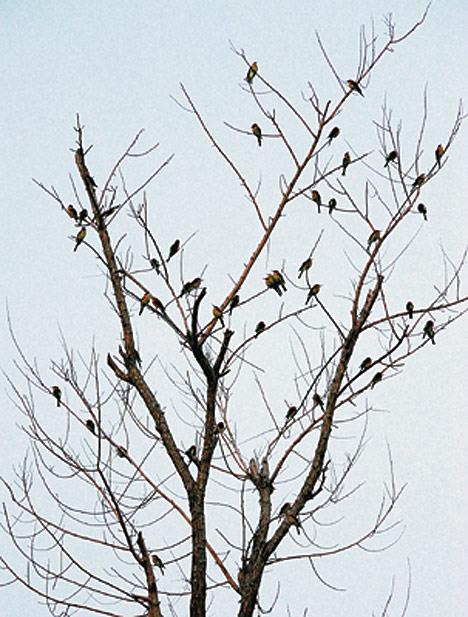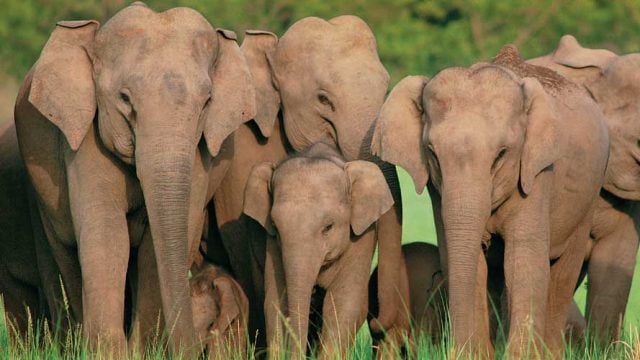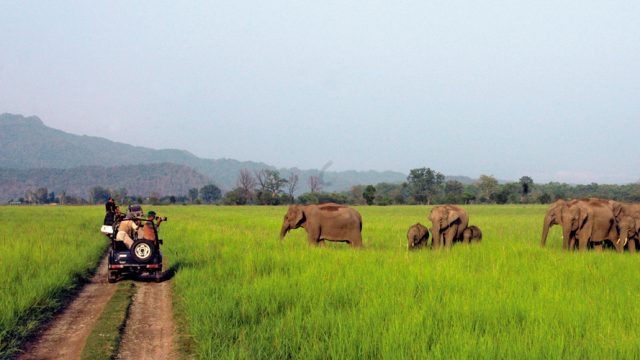Anytime someone mentions a trip to Jim Corbett National Park, two images come to mind. The first:
Four years after my first entry into Corbett, India’s best-known wildlife reserve, the overwhelming memory is that of gazillions of humans, while the tiger itself possibly hid somewhere, nursing a foul mood over this four-wheeled, two-legged invasion. At the sight of this noisy swarming mass, even the most godless of wildlife lovers would chuck a prayer at the nearest temple: “Dear deity, please make these people leave the poor creature alone.”
Therefore, a visit that promised Corbett “beyond the tiger” from a base of eco-tourism luxury excited mild curiosity dampened by cynicism. It was a rolling-the-eyes moment: could it be possible for any sliver of Carpet Sahib’s favourite turf to remain undisturbed by stampeding thrill-seekers? I kept my hopes up, anyway.
The first inkling that this trip might be something out of the box came when our pick-up vehicle left the pukka road, turning into a stretch of the forest where only deep tyre tracks were a sign that people came this way regularly. A kilometre or so of a bumpy ride, and we were at Jim’s Jungle Retreat, located in the buffer zone outside the park, within nudging distance of an elephant’s trunk, a far cry from the tightly packed row of Corbett hotels along NH-121. The rooms have an old-world elegance, with rough-hewn wooden shelving, pale furnishings, bird paintings on the walls, and cushioned window-ledge seating from where to watch the trees and sip on tea. Extremely tiny frogs often take up temporary residence in the bathroom.
Until about two years ago, we were told, the retreat was no different from other cookie-cutter resorts. A prim garden and a “Corbett buffet” did the job efficiently but not with any great distinction. The earlier layout of cottages with some greenery around them has been reversed to greenery with some cottages in it. At present, JJR, as the staff call it, appears to be an extension of the buffer zone forest. A watchtower inside the property allows for all-night vigils by those truly desperate to at least hear the tiger’s roar, if luck does not stretch to seeing its stripes. The food is semi-organic, half of it coming from the resort’s kitchen garden and chicken coop. The Continental lunches and Indian dinners are light, flavoursome and peppered with inventive recipes.
The planting of at least a dozen varieties of native grass and letting the trees grow with abandon has transformed the place in every way. Resident naturalists Ravi and Rahman informed us that most varieties of indigenous bird species that live in Corbett could now be sighted inside the 15-acre resort complex. Our guided nature walk around the resort perimeter scared a small herd of deer into hoofing it. Birds swooped this way and that, busy catching the choice worms. Ravi identified them accurately even in the faint early morning light, while my eyes struggled to spot their silhouette amid so many leaves and branches. Like the presiding lord of the jungle, the tiger is ever present in one’s consciousness. Deliciously dangerous thoughts of seeing it at close range popped up often during this walk, but it rarely bothers to make an appearance unless its human subjects deserve a fright.
Which they often do. Seventy-seven years after its establishment as Hailey National Park, renamed after the great hunter-conservationist Jim Corbett in 1957, the sanctuary and its surrounding areas still witness a mind-numbing scale of tiger slaughter. This year alone, three deaths were reported within a week, triggering news headlines and investigations. Fingers are often pointed at the Van Gujjars, a nomadic tribe subsisting on cattle, and moving around the forest to find ideal grazing grounds. Their movement and their cattle competing with local herbivores for the richest grasslands hurt the tiger’s chances of survival by depleting its prey population. The starving predator sometimes attacks the livestock; the nomads are suspected of revenge killings and also of aiding poachers.
But if the Van Gujjars are at least held accountable, little political will is visible concerning migrants from the Uttarakhand hills who have been steadily usurping protected forest area to expand their illegal settlements. On our day trip to the nearest Gujjar village, we saw active encroachment under way. “They constantly shift the boundary of this illegal village with a fence made of tree branches, grabbing more and more forest land,” said our guide, pointing to houses that were being converted from mud-thatch to brick-and-mortar structures. “They suffocate the tree roots with choona (builder’s lime), preventing them from absorbing water. Not long after, the trees die and topple over. Then the settlers claim this was always farm land.” They get violent when faced with resistance. Just a day or two before our visit, a big clash between the encroachers and foresters had apparently infuriated the latter, and the park gates remained closed in protest, past the opening date.
A cloud of gloom would have hung heavy upon our jeep after this story, but for the uplifting sight of the white flowers of Saccharum spontaneum, better known as kaash or kaans, heralding the autumn. The flowers of this perennial grass bloom briefly just before the season changes — here, they lit up the slopes flanking our arrow-straight road. On one side were small villages and their grazing cattle; on the other, the vast Tumariya reservoir, a birdwatcher’s winter paradise. “Indian animals,” said an umbrella-equipped local, smiling at Sridhar, who was composing photographic masterpieces in green (grass), white (flowers) and black (buffaloes). If the man had hoped to be included in the frame, we disappointed him and sped on. The burning sun was dropping closer to the horizon and we needed to reach the Gujjar village to see, literally, the cows come home.
It was a beautiful village — perfectly symmetrical mud houses with artistic touches; hand-held fans made from jewel-bright threads resting invitingly on colourful rugs; cows, oxen and buffaloes doing their little antics; the village matriarch chatting on a charpoy, surrounded by children who would clearly grow up to be handsome. The Van Gujjars are rather good-looking. While Sridhar gave his full attention to the milking ritual in the cattle shed, my attempts to photograph the pre-teen girls were stymied by loud giggles and repeated escapes into their semi-dark room.
A day trip to this village is one of the excursions organized by JJR, punctuated by a picnic lunch under a tree along the way. The tiger is at the heart of this region, but its magnificence can only be fully appreciated by taking in the other details, the supporting cast of wildlife and humans that complete the picture. The hardiest of tourists go northwards to Marchula to cast a fishing line and sit patiently for the prize catch, mahseer, to bite the bait. The huge, blindingly golden fish is to international anglers these days what the relentlessly hunted tiger had once been to British colonialists and Indian royalty. Not surprisingly, it is on the endangered list. But no individual mahseer gives up without a fight, sometimes forcing an angler to run after it as the powerful fish drags the line down the river. A far better spectacle and fairer combat than two hundred cowardly people and sahibs on elephants chasing one big cat that had not harmed anyone.
On our last day, Sridhar and a few others trooped out at the crack of dawn for a “cycling in the mist” experience. Though it was too early in the season for the real thing, cool winds had swept through the buffer zone the night before, and these intrepid people were looking at twelve kilometres of pedalling before the resort chef could flip an omelette for breakfast. The meals are quite the highlights of any single day at JJR. Not only are they of great quality, but the sprawl of the resort also means a good deal of variety in where the staff set the table. Masala chai on the machaan? You got it. Lunch by the pool? That, too. Dinner on a double-height platform? Absolutely.
By the time the brave boys came back, I had put myself around fresh toast slathered with rosemary-blackcurrant butter. A little birdie told me that lunch that day would include a dessert even better than the previous day’s stewed pear crepe. Whipping up an appetite without doing much exercise is the chief pleasure of being in an oxygen-rich environment — counting calories is the most sinful thing you can do at JJR. Your stomach will never forgive you for pushing away any of this food; so I stayed virtuous and ate double helpings of everything.
At night, sitting on the watchtower, entertained by the forest philharmonic of cicadas, frogs and night birds, we watched our farewell dinner being carried up along a lantern-illuminated path. The man in the lacy pink hat would be unhappy with how we ‘did’ Corbett. “Not even a pug mark?” he would demand to know. Not even that. Really. But then, our eyes and ears had not been hijacked by a convoy of jeeps, shouts of overeager tourists. For the first time, perhaps, we saw and heard the jungle.
The information
Getting there
The Sampark Kranti train leaves Old Delhi station at 4pm and reaches Ramnagar around 8.30pm; from there it’s a 45-min drive to Jim’s Jungle Retreat. Car transfers to and from Ramnagar station are included in the JJR package. To reach by afternoon, one has to drive down from Delhi, starting early morning. Access to the retreat is through the jungle: request a detailed route map from the resort reception (9359792915) or contact the Delhi office (011-43516376; [email protected]).
Getting around
Day excursions from the resort have to be by car, though some cycling tracks allow for several kilometres of solitary pedalling. Walking around the buffer zone jungle is best done in the company of a resort naturalist, as animals do come out of the park perimeter into the buffer zone.
Where to stay
Jim’s Jungle Retreat (jimsjungleretreat.com) has three types of accommodation: cottages for two adults; family cottages for two adults and two children; and lodges (built at first-floor height) for two adults. Tariff for the current season (for Indian nationals) is: Rs 33,000 (cottages); Rs 45,000 (family cottages); and Rs 42,000 (lodges). All prices are for two adults staying two nights. Long-stay discounts applicable from third night.
The resort has serious eco-friendly credentials, with solar geysers and CFL lighting; grey water recycling for irrigation; rainwater harvesting; composting; and use of organic material for laundry. Guests are encouraged to drink the safe RO water supplied in the room, instead of requesting packaged water in plastic bottles.
Food and beverage inclusions in the package are: all daily meals, including breakfast on the day of departure; all soft drinks during stay; afternoon tea with refreshments; evening snacks; refreshments on wildlife activities and safaris. Also included are laundry services and guide fees. Meals are pre-set and always freshly cooked, but guests can specify any dietary requirements.
What to see & do
Included in the JJR package are jeep safaris (3hrs) on sharing basis in the Jhirna and Bijrani forest ranges; elephant rides (1.5hrs) in the Sitabani reserve forest range; walking and cycling safaris (3hrs); birdwatching and village walks (2hrs); flora and fauna interpretation walk (2hrs). Safari permit charges and park fees are included in the tariff.
For an additional charge, the resort can organize an overnight angling trip to Marchula on the Ramganga river (Rs 25,000 on double occupancy basis at Angler’s Shack, including fishing rod and tackle, services of a gillie (river guide) and exclusive jeep for transportation).
Other activities organized for an additional charge are birdwatching drive to Tumariya reservoir and birdwatching drive and heritage trail in Chhoti Haldwani, the village where Jim Corbett lived.
Do it on a budget
You can stay inside Corbett Tiger Reserve at a fraction of the luxury resort cost by booking any of the forest rest houses in Dhikala, Jhirna or Bijrani. They are basic but come with all required amenities. Only the Dhikala rest house has electricity. There is a huge demand for these lodges, so book well in advance. Room tariff, safari charges, and other details are at jimcorbettnationalpark.com/corbett_zone.asp. Kumaon Mandal Vikas Nigam (kmvn.gov.in) organizes Corbett tours from both Delhi and Ramnagar, and has a well-appointed hotel in Mohaan, in the outer zone of the national park.
luxury stay
Nainital
Uttarakhand





